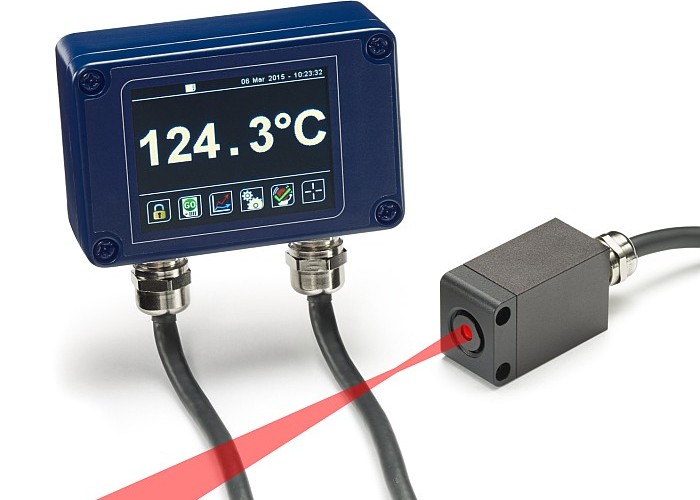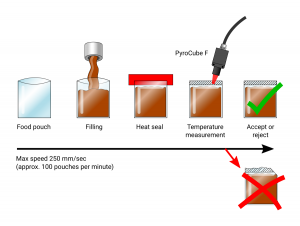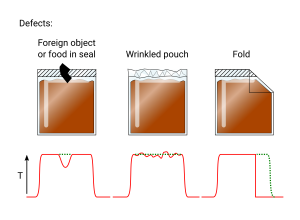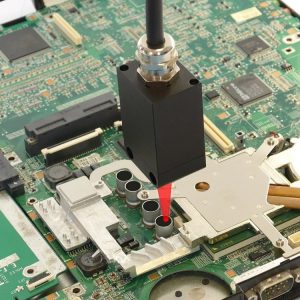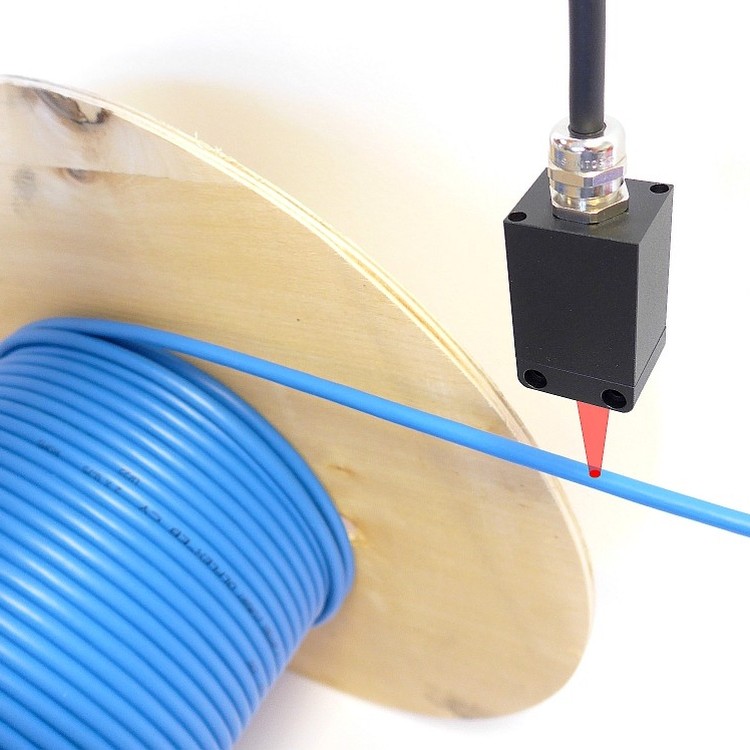PyroCube Applications
If you need a pyrometer with a very small measurement spot size, a very fast response time, or continuous built-in aiming, the PyroCube is ideal. Here are some applications where each of these features can be used.
Fast Response Time
Two lightning-fast response time options are available: 0.01 or 0.001 seconds.
Rejecting Defects in Food Pouch Sealing
After a plastic food pouch is filled, the top is heat-sealed. The pouch then passes the PyroCube sensor, which measures a temperature profile as it passes, to check if the seal is good. The profile is analysed by a PLC that looks for defects and controls a reject chute. If the temperature profile is smooth and lasts the correct length of time, the seal is good.
These defects can occur:
– Temperature profile is uneven: The seal area is wrinkled.
– Temperature drops away briefly, then returns to normal: Foreign object in the seal area (e.g. some food)
– Temperature profile drops away too quickly: There is a fold in the pouch.
The 1 ms response time of the PyroCube-F is necessary because the production line is fast and the reject chute must be operated quickly.
Preform Temperature Measurement in PET Bottle Blow Moulding
Plastic PET bottles are manufactured by heating a “preform”, a test tube shaped piece of plastic, then inflating it inside a mould. Robotic blow-moulding machines typically inflate a group of preforms at the same time; the group is held stationary in front of the sensor for a short time before it is placed in the mould.
After the preforms are heated, the temperature is measured using the PyroCube. The preforms are cooling constantly while they are held before the mould, and it is critical that they are inflated at the right temperature.
The fast response time of the PyroMini allows the temperature to be measured accurately until the last moment before the preforms are placed in the mould, even on fast blow moulding machines. This provides a true indication of the temperature at the very start of the moulding process.
Small Measured Spot Size
Model PCU-S1.6 can measure a spot as small as 1.6 mm in diameter.
Electric Motor Rotor Temperature Measurement
Electric vehicle research and development is now growing rapidly. Motor manufacturers are developing highly efficient power systems, and measuring the temperature of moving parts in R&D applications is an ongoing challenge.
The rotor of an electric motor test rig can be measured through a small hole in the stator or housing using the PyroCube model PCU-S1.6. The fast response time means it is easy to obtain an accurate temperature profile during tests, even if the temperature rise is extremely rapid. If the surface is reflective metal, or if copper windings are visible, the test rotor should be painted to increase its emissivity and allow an accurate measurement.
Ensure the hole is at least twice the size of the sensor’s field of view so that the stator temperature does not influence the rotor temperature measurement – see the optical diagram on the PyroCube data sheet for more information.
Component Temperature in PCB Manufacturing
Circuit board manufacturers need to check the temperature of electronic components in several ways, depending on the type of board and its intended use.
When the board is powered in standard usage conditions, or when testing voltage limits, the temperature of individual components such as integrated circuits may be measured quickly and accurately, thanks to the PyroCube’s small measured spot and built-in aiming light.
The PyroCube can also be used to check the surface temperature of a circuit board that has been heated for ambient operating temperature testing.
Electrical Wire and Cable Manufacturing
Plastic insulation is applied to electrical wires by passing the copper wire through an extruder. After the extruder, the insulation is flame-polished by passing it through a blowtorch-like flame. The outer sheath (jacket) of the cable is also applied using this process.
The polishing flame is controlled by measuring the temperature of the newly-applied insulation with a PyroCube infrared temperature sensor, and connecting the output to a PID controller or PLC. The small spot size allows insulation diameters of 1.6 mm or larger to be measured, and the built-in aim light makes it easy to ensure the sensor is properly aligned.
Continuous Aiming
All PyroCube models have a built-in red LED aiming light, showing exactly where the sensor is aimed, and the size of the measurement spot.
Repositionable Temperature Sensor for Gas Cylinder Filling
The temperature of industrial gas cylinders is monitored continuously as they are filled, and this measurement is used along with the pressure to calculate the volume of gas. The temperature reading also indicates problems during filling, such as valves not opening or closing properly.
A group of cylinders is moved into the filling rig before the gas lines are connected, and the position of the cylinders is not always the same. For this reason, the operator needs to adjust the position of the sensor quickly, and see exactly where it is aiming.
The solution is to use a PyroCube model PCU-S5.5 on rugged, flexible stay-put gooseneck tubing. The built-in aiming light illuminates the measured spot and may be used at distances of up to 200 mm.
Contact Calex for advice on infrared temperature measurement in your application.

